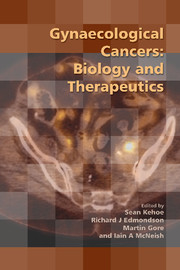Book contents
- Frontmatter
- Contents
- Participants
- Declarations of personal interest
- Preface
- SECTION 1 BIOLOGY OF GYNAECOLOGICAL CANCERS: OUR CURRENT UNDERSTANDING
- SECTION 2 THE TRANSLATION OF BIOLOGY TO THE CLINIC
- SECTION 3 IMAGING AND THERAPY: STATE OF THE ART
- 8 The role of robotics and the future
- 9 ‘Ultra-radical’ surgery in advanced ovarian cancer
- 10 Antivascular therapy in gynaecological cancers
- 11 Oncolytic viral gene therapy in ovarian cancer
- 12 Endometrial cancer: what have the clinical trials taught us?
- 13 Targeting therapies in cancer: opportunities in ovarian cancer
- 14 Functional imaging: from tumour biology to the clinic
- SECTION 4 WHAT QUESTIONS ARE BEING ASKED BY CURRENT CLINICAL TRIALS?
- SECTION 5 CONSENSUS VIEWS
- Index
9 - ‘Ultra-radical’ surgery in advanced ovarian cancer
from SECTION 3 - IMAGING AND THERAPY: STATE OF THE ART
Published online by Cambridge University Press: 05 February 2014
- Frontmatter
- Contents
- Participants
- Declarations of personal interest
- Preface
- SECTION 1 BIOLOGY OF GYNAECOLOGICAL CANCERS: OUR CURRENT UNDERSTANDING
- SECTION 2 THE TRANSLATION OF BIOLOGY TO THE CLINIC
- SECTION 3 IMAGING AND THERAPY: STATE OF THE ART
- 8 The role of robotics and the future
- 9 ‘Ultra-radical’ surgery in advanced ovarian cancer
- 10 Antivascular therapy in gynaecological cancers
- 11 Oncolytic viral gene therapy in ovarian cancer
- 12 Endometrial cancer: what have the clinical trials taught us?
- 13 Targeting therapies in cancer: opportunities in ovarian cancer
- 14 Functional imaging: from tumour biology to the clinic
- SECTION 4 WHAT QUESTIONS ARE BEING ASKED BY CURRENT CLINICAL TRIALS?
- SECTION 5 CONSENSUS VIEWS
- Index
Summary
Introduction
Over the past four decades, increased understanding of the pathophysiology and behaviour of gynaecological peritoneal surface malignancies has led to significant advances in effective treatment modalities. Numerous studies have shown that surgical cytoreduction of all visible tumour in the peritoneal cavity plays a crucial role in optimising survival from these diseases. Consequently, the surgical management of advanced ovarian, primary peritoneal and fallopian tube cancers has evolved from basic gynaecological oncology procedures (hysterectomy, salpingo-oophorectomy, omentectomy, and pelvic and para-aortic lymph node dissection) to the incorporation of more comprehensive surgical cytoreductive procedures as part of a maximal surgical effort. These extensive procedures often target peritoneal surfaces that involve multiple ‘non-gynaecological’ organs and sites such as the small intestine, colon, diaphragm, liver, porta hepatis, gall bladder, spleen, pancreas, stomach, coeliac axis, mediastinal lymph nodes and pleural cavity.
Individually, each of the procedures used in a maximal cytoreductive effort are performed by surgeons throughout the world. However, the performance of many if not all of the various upper abdominal and pelvic procedures in women with gynaecological malignancies is not necessarily done nor accepted internationally, and hence some refer to the combination of these procedures in individual women for cytoreductive purposes as ‘ultra-radical’. Unquestionably, these procedures require detailed knowledge of upper abdominal anatomy not generally taught in gynaecological oncology training programmes. Consequently, there is a potential for ‘non-gynaecological’ perioperative complications in addition to those that may be encountered in more standard gynaecological oncology surgery.
Keywords
- Type
- Chapter
- Information
- Gynaecological CancersBiology and Therapeutics, pp. 109 - 120Publisher: Cambridge University PressPrint publication year: 2011



